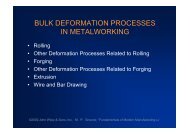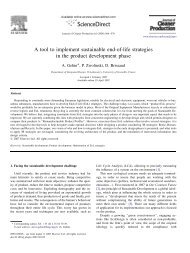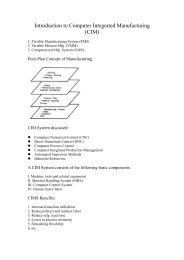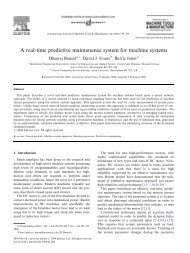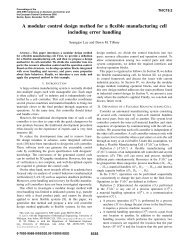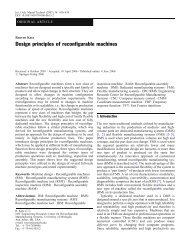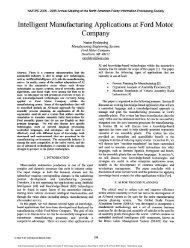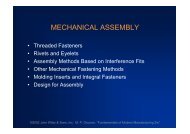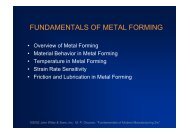Chapter 4: Transient Heat Conduction
Chapter 4: Transient Heat Conduction
Chapter 4: Transient Heat Conduction
You also want an ePaper? Increase the reach of your titles
YUMPU automatically turns print PDFs into web optimized ePapers that Google loves.
<strong>Chapter</strong> 4:<strong>Transient</strong> <strong>Heat</strong> <strong>Conduction</strong>Yoav PelesDepartment of Mechanical, Aerospace and Nuclear EngineeringRensselaer Polytechnic InstituteCopyright © The McGraw-Hill Companies, Inc. Permission required for reproduction or display.
ObjectivesWhen you finish studying this chapter, you should be able to:• Assess when the spatial variation of temperature is negligible,and temperature varies nearly uniformly with time, making thesimplified lumped system analysis applicable,• Obtain analytical solutions for transient one-dimensionalconduction problems in rectangular, cylindrical, and sphericalgeometries using the method of separation of variables, andunderstand why a one-term solution is usually a reasonableapproximation,• Solve the transient conduction problem in large mediums usingthe similarity variable, and predict the variation of temperaturewith time and distance from the exposed surface, and• Construct solutions for multi-dimensional transient conductionproblems using the product solution approach.
Lumped System Analysis• In heat transfer analysis, some bodies are essentiallyisothermal and can be treated as a “lump” system.• An energy balance of an isothermal solid for the timeinterval dt can be expressed asA s<strong>Heat</strong> Transferinto the bodyduring dt=The increase in theenergy of the bodyduring dtSOLID BODYm = masshV = volumeTρ = densityT i = initial temperatureT = T(t)hA s (T -T)dt= mc p dT(4–1)Q= hAs⎡⎣T∞−T t( )⎤⎦
• Noting that m=ρV and dT=d(T-T ) since T constant, Eq. 4–1 can be rearranged asd( T −T ) ∞ hAs= dtT −T ρVc∞• Integrating from time zero (at which T=T i ) to t givesTt () −T∞hAsln = t(4–3)T −T ρVci∞• Taking the exponential of both sides and rearrangingTt () −T∞−bthAs= e ; b=(1/s)T −T ρVci∞• b is a positive quantity whose dimension is (time) -1 ,and is called the time constant.ppp(4–2)(4–4)
There are several observations that can be made from this figure andthe relation above:1. Equation 4–4 enables us to determine the temperature T(t) of abody at time t, or alternatively, the time t required for thetemperature to reach a specified value T(t).2. The temperature of a body approaches the ambient temperature Texponentially.3. The temperature of the bodychanges rapidly at the beginning,but rather slowly later on.4. A large value of b indicatesthat the body approachesthe ambient temperaturein a short time.
Rate of Convection <strong>Heat</strong> Transfer• The rate of convection heat transfer between the bodyand the ambient can be determined from Newton’slaw of cooling(4–6)[ ]Qt () = hAsTt () −T ∞(W)• The total heat transfer between the body and theambient over the time interval 0 to t is simply thechange in the energy content of the body:[ ]Q= mcpT( t) − T ∞(kJ) (4–7)• The maximum heat transfer between the body and itssurroundings (when the body reaches T )[ ]Qmax = mcpTi− T ∞(kJ) (4–8)
Criteria for Lumped System Analysis• Lumped system is not always appropriate,characteristic length L = V Acs• and a Biot number (Bi) asBi• It can also be expressed asLcRcondBi = k1= R=convhhL c= (4–9)k<strong>Conduction</strong> resistance within the bodyConvection resistance at the surface of the bodyR conv R condT hT sT in
• Lumped system analysis assumes a uniformtemperature distribution throughout the body, which istrue only when the thermal resistance of the body toheat conduction is zero.• The smaller the Bi number, the more accurate thelumped system analysis.• It is generally accepted that lumped system analysis isapplicable ifBi ≤ 0.1
<strong>Transient</strong> <strong>Heat</strong> <strong>Conduction</strong> in Large Plane Walls,Long Cylinders, and Spheres with Spatial Effects• In many transient heat transfer problems the Biot numberis larger than 0.1, and lumped system can not be assumed.• In these cases the temperature within the body changesappreciably from point to point as well as with time.• It is constructive to first consider the variation oftemperature with time and position in one-dimensionalproblems of rudimentary configurations such as a largeplane wall, a long cylinder,and a sphere.
A large Plane Wall• A plane wall of thickness 2L.• Initially at a uniform temperature of T i .• At time t=0, the wall is immersed in afluid at temperature T .• Constant heat transfer coefficient h.• The height and the width of the wallare large relative to its thickness one-dimensional approximationis valid.• Constant thermophysical properties.• No heat generation.• There is thermal symmetry about the midplane passingthrough x=0.
The <strong>Heat</strong> <strong>Conduction</strong> Equation• One-dimensional transient heat conduction equationproblem (0≤ x ≤ L):Differential equation:2∂ T2∂x1 ∂T=α ∂t(4–10a)Boundary conditions:( 0, t)⎧∂T= 0⎪ ∂x(4–10b)⎨⎪ ∂T( L,t)− k = h⎡T( L,t)−T∞⎤⎪⎩∂x⎣ ⎦Initial condition:( )T x,0 = Ti(4–10c)
Non-dimensional Equation• A dimensionless space variableX=x/L• A dimensionless temperature variableθ(x, t)=[T(x,t)-T ]/[T i -T ]• The dimensionless time and h/k ratio will be obtained through theanalysis given below• Introducing the dimensionless variable into Eq. 4-10a∂θ ∂θ ∂ ∂ θ ∂ ∂θ∂= = ; = ; =2 2 2L T L T 1 T2 2∂X ∂( x/ L)Ti −T∞ ∂x ∂X Ti −T∞ ∂x ∂t Ti−T∞∂t• Substituting into Eqs. 4–10a and 4–10b and rearranging( t)( t)2 2 2∂ θ L ∂ T ∂θ∂θ1, hL ∂θ0,= ; = θ2 2( 1, t); = 0∂X α ∂x ∂t ∂X k ∂X(4–11)
• Therefore, the dimensionless time is τ=αt/L 2 , whichis called the Fourier number (Fo).• hL/k is the Biot number (Bi).• The one-dimensional transient heat conductionproblem in a plane wall can be expressed innondimensional form as2∂ θ ∂θDifferential equation: =2∂X∂τ(4–12a)Boundary conditions:Initial condition:⎧∂θ⎪ ∂X⎨⎪ ∂ θ⎪⎩∂X( 0, τ)( 1, τ)=θ ( X ,0)= 10=−Biθ( 1, τ )(4–12b)(4–12c)
Exact Solution• Several analytical and numerical techniques can beused to solve Eq. 4-12.• We will use the method of separation of variables.• The dimensionless temperature function θ(X,τ) isexpressed as a product of a function of X only and afunction of τ only asθ ( X,τ) = F( X) G( τ)(4–14)• Substituting Eq. 4–14 into Eq. 4–12a and dividing bythe product FG gives21 d F 1 dG=2(4–15)FdX Gdτ
• Since X and τ can be varied independently, theequality in Eq. 4–15 can hold for any value of X and τonly if Eq. 4–15 is equal to a constant.• It must be a negative constant that we will indicate by-λ 2 since a positive constant will cause the functionG(τ) to increase indefinitely with time.• Setting Eq. 4–15 equal to -λ 2 gives2d F 2 dG 2+ λ F = 0 ; + λ F = 0 (4–16)2dXdτ• whose general solutions are⎧ ⎪F = C1cosλX + C2sinλX⎨2−⎪⎩ G=C3e λτ( ) ( )(4–17)
2−λτθ = FG = C3e ⎡⎣C1cos λX + C2sinλX( ) ( )2−λτ= e ⎡⎣Acos( λX) + Bsin( λX)⎤⎦• where A=C 1 C 3 and B=C 2 C 3 are arbitrary constants.• Note that we need to determine only A and B toobtain the solution of the problem.• Applying the boundary conditions in Eq. 4–12b gives∂θ∂θ( 1, τ)∂X( 0, τ)∂X2( λ λ )−λτ= 0→− e A sin0+ B cos0 = 0( )2⎤⎦( λ )−λτ→ B = 0 → θ = Ae cos X2 2−λτ−λτ=−Biθ 1, τ →− Ae λsin λ =−BiAecos λ(4–18)→ λtanλ = Bi
• But tangent is a periodic function with a period of π, and the equationλtan(λ)=Bi has the root λ 1 between 0 and π, the root λ 2 between π and2π, the root λ n between (n-1)π and nπ, etc.• To recognize that the transcendental equation λtan(λ)=Bi has aninfinite number of roots, it is expressed asλn tan λn= Bi(4–19)• Eq. 4–19 is called the characteristic equation or eigenfunction, andits roots are called the characteristic values or eigenvalues.• It follows that there are an infinite number of solutions of the form2−λτθ = Ae cos( λ X), and the solution of this linear heat conductionproblem is a linear combination of them,∞n=12n−λτθ = ∑ Ae cos λ X (4–20)n( )• The constants A n are determined from the initial condition, Eq. 4–12c,θX,0 1 1 A cos λ X( ) ( )∞n=1nn= → =∑ (4–21)n
• Multiply both sides of Eq. 4–21 by cos(λ m X), andintegrating from X=0 to X=1X= 1 X= 1∞∫( λ X ) ( λ X) A ( λ X)cos = cos ∑ cosm m n nX= 0 X=0n=1• The right-hand side involves an infinite number ofintegrals of the form∫X = 1∫X = 0cosλ Xcos( ) ( )• It can be shown that all of these integrals vanish exceptwhen n=m, and the coefficient A n becomesX= 1 X=1∫cosλ X dX = A cos λ X dX( )2( )n n nX= 0 X=0∫m→ A =nλ X dXn4sinλn2λ+ sin 2λn( )n(4–22)
• Substituting Eq. 4-22 into Eq. 20a givesθ =∞∑4sinλ2λ+ sin 2λ( )n=1 n nne2n−λτcosλ X( )n• Where λ n is obtained from Eq. 4-19.• As demonstrated in Fig. 4–14, theterms in the summation declinerapidly as n and thus λ n increases.• Solutions in other geometries suchas a long cylinder and a sphere canbe determined using the sameapproach and are given in Table 4-1.FIGURE 4-14
Summary of the Solutions for One-Dimensional <strong>Transient</strong> <strong>Conduction</strong>
Approximate Analytical andGraphical Solutions• The series solutions of Eq. 4-20 and in Table 4–1 convergerapidly with increasing time, and for τ >0.2, keeping the firstterm and neglecting all the remaining terms in the series resultsin an error under 2 percent.• Thus for τ >0.2 the one-term approximation can be usedT( x, t)−Tθwall= =1cos λ1/ , τ > 0.2T −T2∞ −λτPlane wall: Ae ( )1 x Li2∞ −λτCylinder: Ae ( )1 J r rSphere:∞Trt (,) −Tθcyl= =1 0λ1 /0, τ > 0.2T −Tθsphi∞Trt (,) −T2( λ r r )sin /∞ −λτ11 0= = Ae1τ >Ti−T∞λ1r/r0, 0.2(4–23)(4–24)(4–25)
• The constants A 1 and λ 1 are functions of the Bi numberonly, and their values are listed in Table 4–2 against the Binumber for all three geometries.• The function J 0 is the zeroth-order Bessel function of thefirst kind, whose value can be determined from Table 4–3.
The solution at the center of a plane wall, cylinder,and sphere:Center of plane wall (x=0): θCenter of cylinder (r=0):Center of sphere (r=0):θθT −T= =A e0 ∞0, wall1Ti−T∞T −T= =A e0 ∞0, cyl1Ti−T∞sphT0 ∞= =Ti−T−T∞A e121−λ τ21−λ τ21−λ τ(4–26)(4–27)(4–28)
Heisler Charts• The solution of the transient temperature for a largeplane wall, long cylinder, and sphere are alsopresented in graphical form for τ>0.2, known as thetransient temperature charts (also known as theHeisler Charts).• There are three charts associated with each geometry:–the temperature T 0 at the center of the geometry at agiven time t.–the temperature at other locations at the same timein terms of T 0 .– the total amount of heat transfer up to the time t.
Heisler Charts – Plane WallMidplane temperature
Heisler Charts – Plane WallTemperature distribution
<strong>Heat</strong> Transfer
<strong>Heat</strong> Transfer• The maximum amount of heat that a body can gain (orlose if T i =T ) occurs when the temperature of the bodyis changes from the initial temperature T i to theambient temperature( ) ρ ( )Qmax = mcp T∞− Ti = Vcp T∞− Ti(kJ) (4–30)• The amount of heat transfer Q at a finite time t is canbe expressed as( )Q= ∫ ρcp⎡⎣T x, t -Ti⎤⎦dV(4–31)V
• Assuming constant properties, the ratio of Q/Q maxbecomesρc ⎡T x, t -T ⎤dV( )∫ piQ⎣ ⎦V1= = −Q c T T V V( - )( 1 )∫ V dV (4–32)maxρp ∞ i V• The following relations for the fraction of heat transferin those geometries:Plane wall:⎛⎜⎝QQ⎞θsin λ1λ⎟ = 1−0, wallmax ⎠wall1(4–33)Cylinder:⎛⎜⎝QQ⎞= 1−2θcyl( λ )1 1⎟0,max ⎠λcyl1J(4–34)⎛ Qsin λ λ cos λ⎜⎞ ⎟ = 1−3θ−sph⎝QSphere: 1 1 10, 3max ⎠λsph1(4–35)
Remember, the Heisler charts are notgenerally applicableThe Heisler Charts can only be used when:• the body is initially at a uniform temperature,•the temperature of the medium surroundingthe body is constant and uniform.•the convection heat transfer coefficient isconstant and uniform, and there is no heatgeneration in the body.
Fourier number2αtkL ( 1/ L)∆Tτ = = =L ρc L / t ∆T2 3pThe rate at which heat is conductedacross L of a body of volume L 3The rate at which heat is storedin a body of volume L 3• The Fourier number is a measure of heat conductedthrough a body relative to heat stored.• A large value of the Fourier number indicates fasterpropagation of heat through a body.
<strong>Transient</strong> <strong>Heat</strong> <strong>Conduction</strong> in Semi-Infinite Solids• A semi-infinite solid is an idealizedbody that has a single plane surfaceand extends to infinity in alldirections.• Assumptions:– constant thermophysical properties– no internal heat generation– uniform thermal conditions on its exposed surface– initially a uniform temperature of T i throughout.• <strong>Heat</strong> transfer in this case occurs only in the directionnormal to the surface (the x direction)one-dimensional problem.
• Eq. 4–10a for one-dimensional transient conduction inCartesian coordinates appliesDifferential equation:Boundary conditions:Initial condition:2∂ T 1 ∂T=2∂xα ∂t⎪⎧ T( 0, t)= Ts⎨⎪⎩ T( x→∞ , t)= Ti( )T x,0 = Ti(4–10a)(4–37b)(4–10c)• The separation of variables technique does not workin this case since the medium is infinite.• The partial differential equation can be converted intoan ordinary differential equation by combining thetwo independent variables x and t into a singlevariable η, called the similarity variable.
Similarity Solution• For transient conduction in a semi-infinite mediumxSimilarity variable: η =4αt• Assuming T=T(η) (to be verified) and using the chainrule, all derivatives in the heat conduction equationcan be transformed into the new variable(4–39a)2∂ T2∂x=1 ∂Tα ∂t2∂ T∂η=−22∂Tη∂η
2∂ T∂η• Noting that η=0 at x=0 and η as x (and alsoat t=0) and substituting into Eqs. 4–37b (BC) give,after simplification( 0 ) ; ( η )T = T T →∞ = T (4–39b)s=−22∂Tη∂η• Note that the second boundary condition and the initialcondition result in the same boundary condition.• Both the transformed equation and the boundaryconditions depend on h only and are independent of xand t. Therefore, transformation is successful, and η isindeed a similarity variable.i(4–39a)
• To solve the 2nd order ordinary differential equation in Eqs. 4–39, we define a new variable w as w=dT/dη. This reduces Eq. 4–39a into a first order differential equation than can be solved byseparating variables,dw dw22ηw 2ηdη ln( w) η C0dη =− → w=− → =− + 2→ w=Ce −η• where C 1 =ln(C 0 ).• Back substituting w=dT/dη and integrating again,η2∫−u(4–40)T = C e du+C1 20• where u is a dummy integration variable. The boundarycondition at η=0 gives C 2 =T s , and the one for η givesπT = C e du+ C = C + T → C =i∞( T −T)2∫−ui s(4–41)s1 2 1 1202π1
• Substituting the C 1 and C 2 expressions into Eq. 4–40and rearranging,TT• Wherei−T2s2 −u= ∫ e du = erf ( η ) = 1−erfc( η ) (4–42)−Tπsη• are called the error functionand the complementary errorfunction, respectively, ofargument η.η02 2 2−u2 −uerf ( η) = e du ; erfc( η)= 1−e duππ∫ ∫ (4–43)0 0η
• Knowing the temperature distribution, the heat flux atthe surface can be determined from the Fourier’s lawto be( −T)∂T∂T∂η2−η1 k Tsiqs=− k =− k =− kCe1=∂x x= 0∂η ∂x η = 04αt η = 0 παt(4–44)
Other Boundary Conditions• The solutions in Eqs. 4–42 and 4–44 correspond tothe case when the temperature of the exposed surfaceof the medium is suddenly raised (or lowered) to T s att=0 and is maintained at that value at all times.• Analytical solutions can be obtained for otherboundary conditions on the surface and aregiven in the book– Specified Surface Temperature, T s = constant.– Constant and specified surface heat flux.– Convection on the Surface,– Energy Pulse at Surface.
<strong>Transient</strong> <strong>Heat</strong> <strong>Conduction</strong> inMultidimensional Systems• Using a superposition approach called theproduct solution, the one-dimensional heatconduction solutions can also be used toconstruct solutions for some two-dimensional(and even three-dimensional) transient heatconduction problems.• Provided that all surfaces of the solid aresubjected to convection to the same fluid attemperature, the same heat transfer coefficienth, and the body involves no heat generation.
Example short cylinder• Height a and radius r o .• Initially uniform temperature T i .• No heat generation• At time t=0:– convection T – heat transfer coefficient h• The solution:( , , ) ( , ) ( , )⎛T r x t −T∞ ⎞ ⎛T x t −T∞ ⎞ ⎛T r t −T∞⎞⎜ ⎟ = ⎜ ⎟ X ⎜ ⎟⎝ T −T ⎠ ⎝ T −T ⎠ ⎝ T −T⎠i ∞ Short i ∞ plane i ∞ infiniteCylinder wall cylinder(4–50)
• The solution can be generalized as follows: thesolution for a multidimensional geometry is theproduct of the solutions of the one-dimensionalgeometries whose intersection is the multidimensionalbody.• For convenience, the one-dimensional solutions aredenoted by⎛T( x,t)−T∞⎞θ ( xt , )θθwallcyl( rt , )semi-inf( xt , )= ⎜ ⎟⎝ Ti−T∞⎠( , )⎛T r t −T∞⎞= ⎜ ⎟⎝ Ti−T∞⎠( , )planewallinfinitecylinder⎛T x t −T∞⎞= ⎜ ⎟⎝ Ti−T∞⎠semi-infinitesolid(4–51)
Total <strong>Transient</strong> <strong>Heat</strong> Transfer• The transient heat transfer for a two dimensional geometryformed by the intersection of two one-dimensionalgeometries 1 and 2 is:⎛ Q ⎞ ⎛ Q ⎞ ⎛ Q ⎞ ⎡ ⎛ Q ⎞ ⎤⎜ ⎟ = ⎜ ⎟ + ⎜ ⎟ ⎢1-⎜ ⎟ ⎥⎝Qmax ⎠ Qtotal, 2D⎝ max ⎠ Q1 ⎝ max ⎠ Q2 ⎢⎣⎝ max ⎠1⎥⎦(4–53)• <strong>Transient</strong> heat transfer for a three-dimensional (intersectionof three one-dimensional bodies 1, 2, and 3) is:⎛ Q ⎞ ⎛ Q ⎞ ⎛ Q ⎞ ⎡ ⎛ Q ⎞ ⎤⎜ ⎟ = ⎜ ⎟ + ⎜ ⎟ ⎢1-⎜ ⎟ ⎥⎝Qmax ⎠ Qtotal, 3D⎝ max ⎠ Q1 ⎝ max ⎠ Q2 ⎢⎣⎝ max ⎠1⎥⎦⎛ Q ⎞ ⎡ ⎛ Q ⎞ ⎤⎡ ⎛ Q ⎞ ⎤+ ⎜ ⎟ ⎢1- ⎜ ⎟ ⎥⎢1-⎜ ⎟ ⎥⎝Qmax ⎠ Q3⎢⎣ ⎝ max ⎠ Q1⎥⎢ ⎦⎣ ⎝ max ⎠2⎥⎦(4–54)




